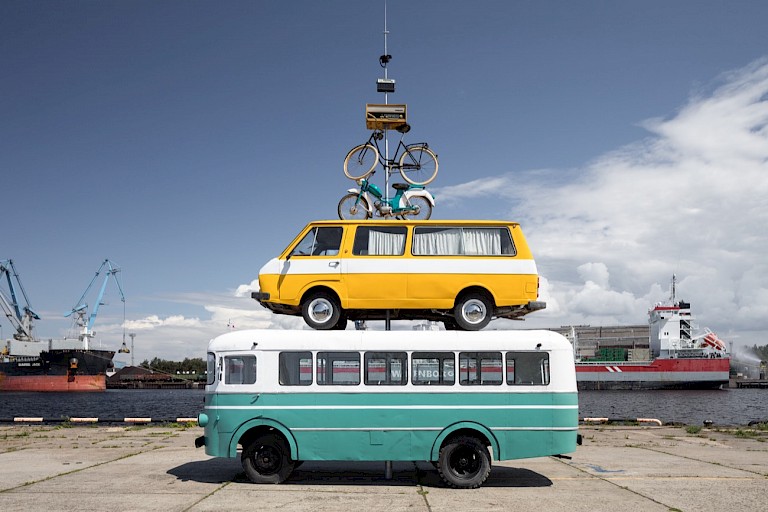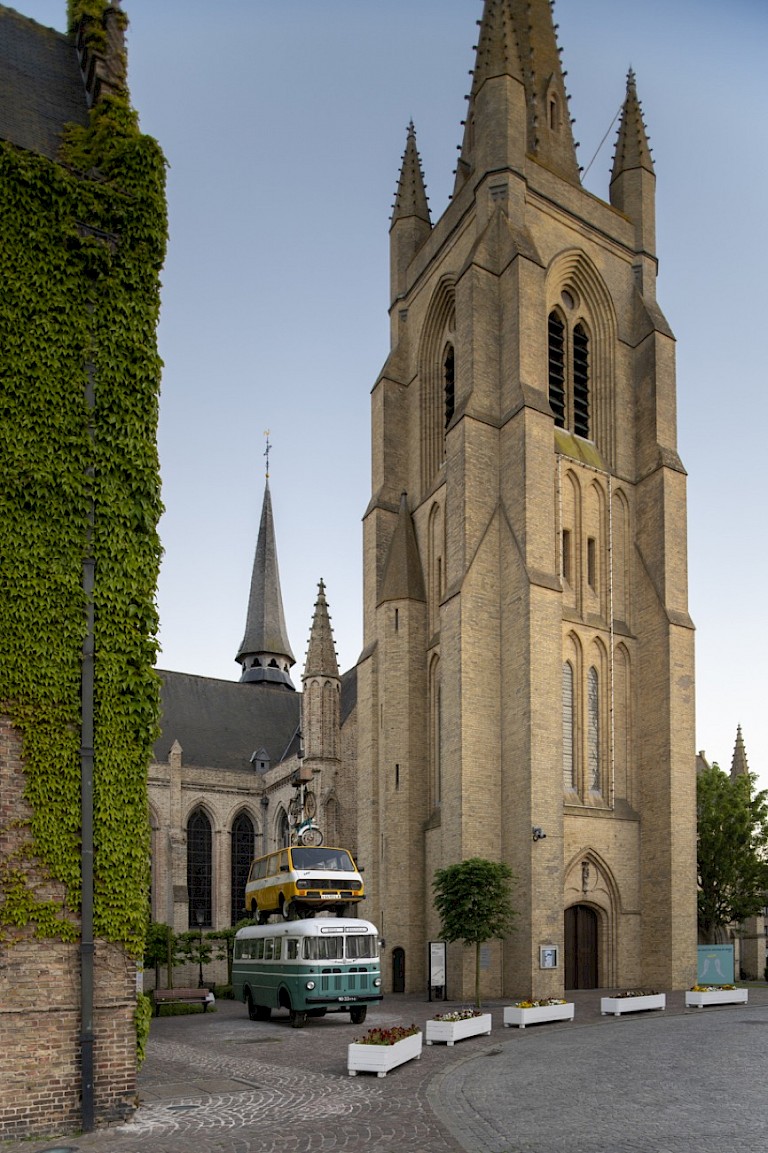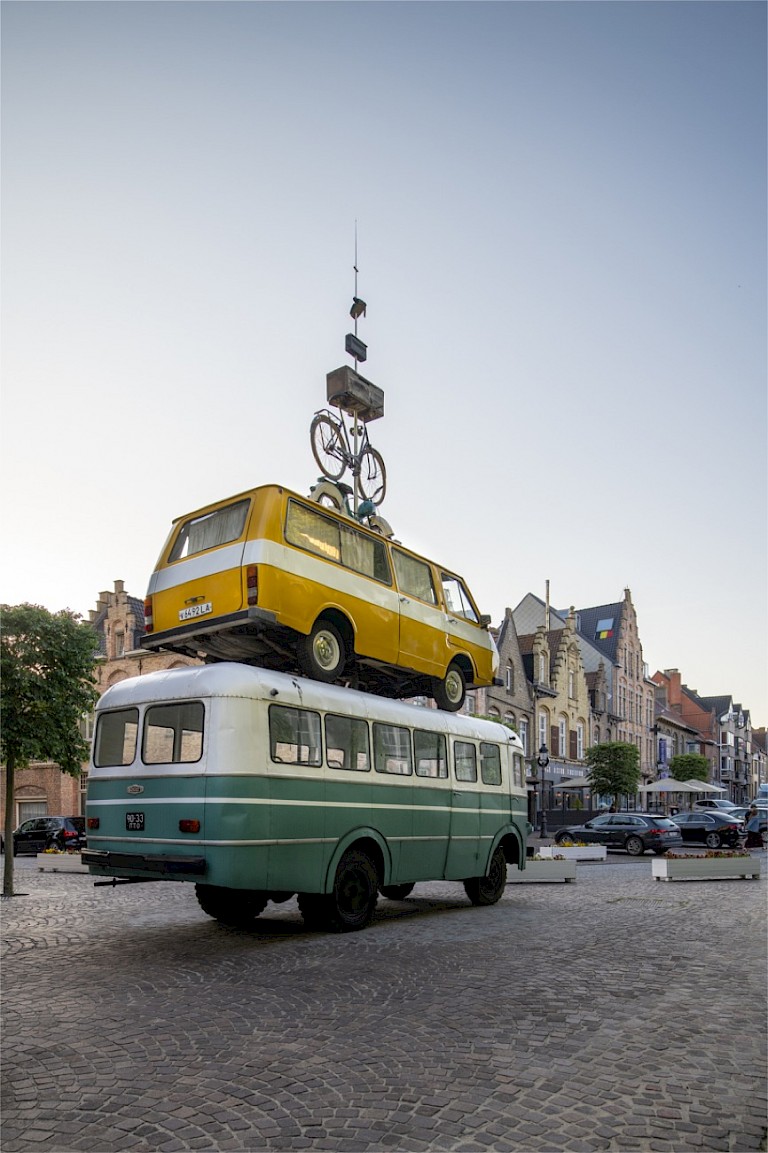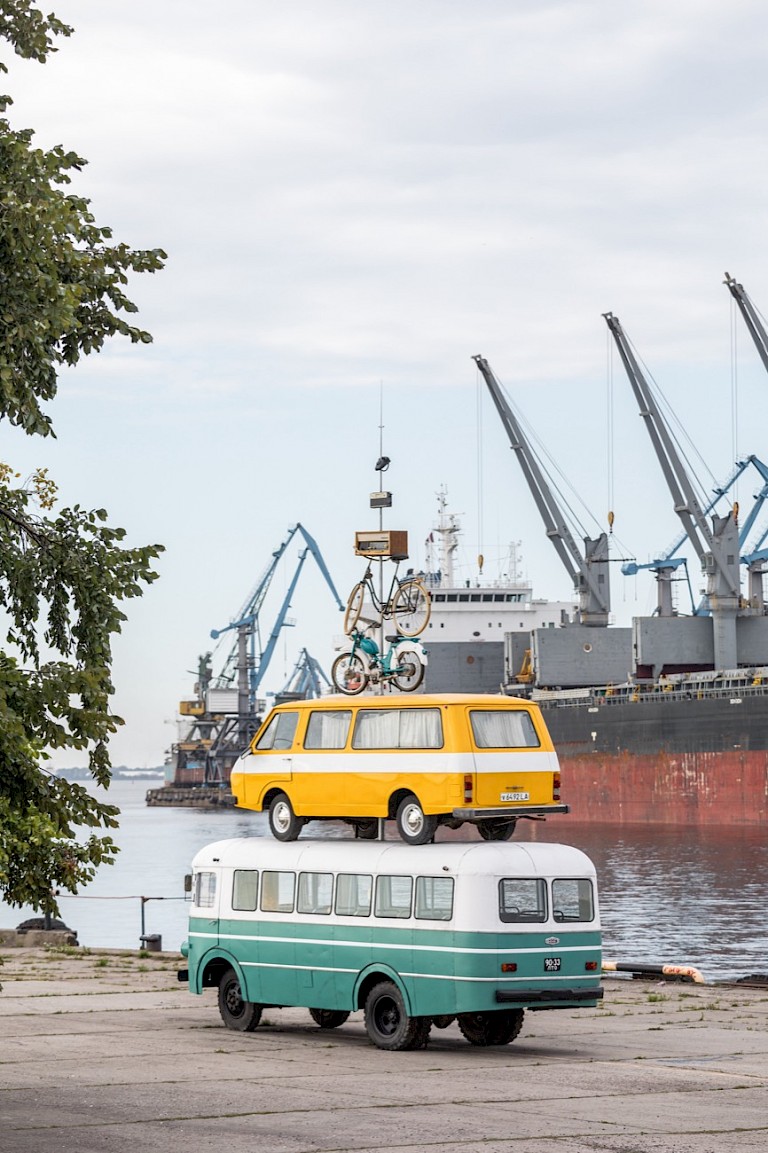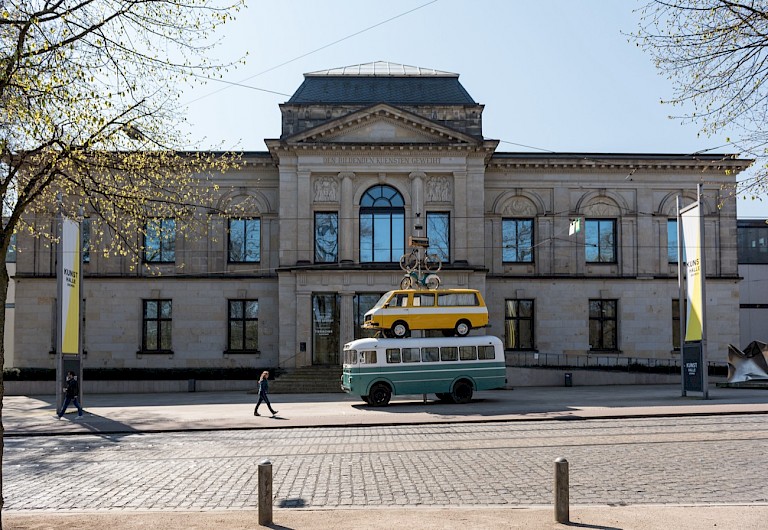



The inception of "Pinpointing Progress" was a result of the artist Maarten Vanden Eynde's long-held interest in the idea of preserving objects on a spike, like insects in a museum. It was his commission for the Riga Biennial that helped him uncover the wealth of vital and iconic objects that were manufactured in Riga during the Soviet era. This discovery served as the catalyst for the artwork. Furthermore, the serendipitous connection between Riga, allegedly founded by merchants from Bremen, and Bremen, its official sister city, lent an extra layer of symbolism to the project whose form quotes the “Town Musicians of Bremen” sculpture.Vanden Eynde’s research was pivotal to the creation of this artwork, given the unfamiliarity of the context. He used the internet, books, and conducted site visits, including explorations of old industrial sites and the Riga Motor Museum, which collaborated with the artist and played a significant role in advising and contributing to the restoration of certain items. The emphasis on local engagement was a vital component of his practice, fostering a strong sense of connection between the artwork and the local community. The project's local production and completion also encouraged local support and participation.The individual components of the artwork each carry unique historical and cultural significance. The restoration of the bus, a RAF-251, presented a formidable challenge, as it was in a dilapidated state. Vanden Eynde and his team had to merge parts from two of the three remaining buses of this type to create a pristine replica. Other components, such as the car, moped, bicycle, radio, telephone, camera, and transistor, were sourced from auctions and second-hand shops.One notable outcome of the artwork was the unexpected appropriation movement it inspired, leading to thousands of performative Instagram posts, primarily featuring women posing in front of the installation — some people even chose the work as a backdrop for their wedding pictures. This phenomenon, rooted in the digital sphere, highlighted the contrast between the materiality of industrial production referenced by the artwork and the immateriality of the digital economy, cognitive capitalism, and biopolitics underlying this phenomenon. It underscored the complex relationship between the physical and virtual realms in contemporary society.After Riga, “Pinpointing Progress” also traveled to the Kunsthalle in Bremen, Germany and after that in front of the Museum of the French Revolution in Vizille, France. However, it was in Riga that the work had the most resonance and the strongest response from the community. The installation is currently owned by Verbeke Foundation in Belgium.
"Pinpointing Progress” stands as an exemplary work of art that combines the ability to reach the broadest public with profound insight into the complex interplay of history, technology, and the human condition. It is a thought-provoking and visually striking monument that transcends traditional artistic boundaries and continues to engage audiences in meaningful ways.“Pinpointing Progress” delves into numerous issues of the present, including the decline of material-based production in the Western world, the shrinking of technological components, the rapid obsolescence of technology, and the ideological underpinnings of economic policies. It critiques the exponential growth, known as the Great Acceleration, and the shift from manufacturing to a service industry. This transformation is closely tied to the digital revolution, represented by the transistor on the artwork’s spike. The artwork also serves as a reminder of the environmental impact of the Anthropocene era, where humanity's imprint on Earth has become both permanent and pervasive. The project also touches upon concepts such as Moore's Law and Planned Obsolescence. Moore’s Law, which once promised exponential growth in computer technology, has now reached its material limits, necessitating the evolution of computer technology. Planned Obsolescence, however, is critiqued as a detrimental practice that generates excessive waste and exacerbates the depletion of natural resources, a hallmark of capitalist production."Pinpointing Progress" is not merely a static installation; it has also catalyzed a remarkable and unexpected appropriation movement, particularly on social media. Thousands of individuals, predominantly women, have embraced the artwork, using it as a backdrop for their personal expressions, performances, and photos. This unanticipated response demonstrates the artwork’s ability to resonate with diverse audiences, sparking engagement and dialogue far beyond the conventional boundaries of art.The artwork’s engagement with the public, its restoration process, and its ability to spark such an intriguing response on social media exemplify the artist's dedication to local involvement and community participation. It has transformed the installation into a dynamic, living piece of art that continues to evolve as it interacts with its surroundings and the people who engage with it."Pinpointing Progress" also serves as a commentary on the impact of technological advancement on our environment and the shifting landscape of industrial production. It raises critical questions about the fast-paced changes in technology and the challenges we face in preserving the relics of our industrial past. These themes resonate with contemporary concerns about sustainability and the consequences of our consumption-driven culture.In conclusion, "Pinpointing Progress" is an outstanding artwork that excels in many aspects. Its compelling visual impact, profound thematic exploration, placemaking and engagement with the local community, and unexpected resonance on social media make it an exemplary piece of public art. The artwork not only reflects the artist's talent and vision but also speaks to the complexities of our modern world.
Maarten Vanden Eynde, born in Leuven, Belgium, in 1977, is an artist whose work delves into the complexities of the modern world, focusing on the intersections of ecology, anthropology, and archaeology. Vanden Eynde has pioneered the concept of “Genetology,” a multidisciplinary science that underpins his artistic practice. His works have received international recognition and have been showcased in prestigious institutions and exhibitions worldwide. Notable solo exhibitions include "Catastrophic Casualties & Casual Catastrophes" at Meessen De Clercq in Brussels, "Museum of Forgotten History XXX" at MuHKA in Antwerp, and "Industrial Evolution" at Meessen De Clercq, among many others.Vanden Eynde's extensive research and art practice have revolved around the Anthropocene. His work often engages with the materiality of objects, examining their origins, transformations, and eventual remnants. He is committed to unraveling the processes and consequences of time, offering a unique perspective on the environmental challenges and ecological issues of our time.Currently pursuing a Ph.D. as a part of the "Matter, Gesture, Soul" Artistic Research project at the University of Bergen, Norway, Maarten Vanden Eynde continues to be at the forefront of contemporary art, investigating the influence of transatlantic trade on the evolution of humankind and global power structures.
